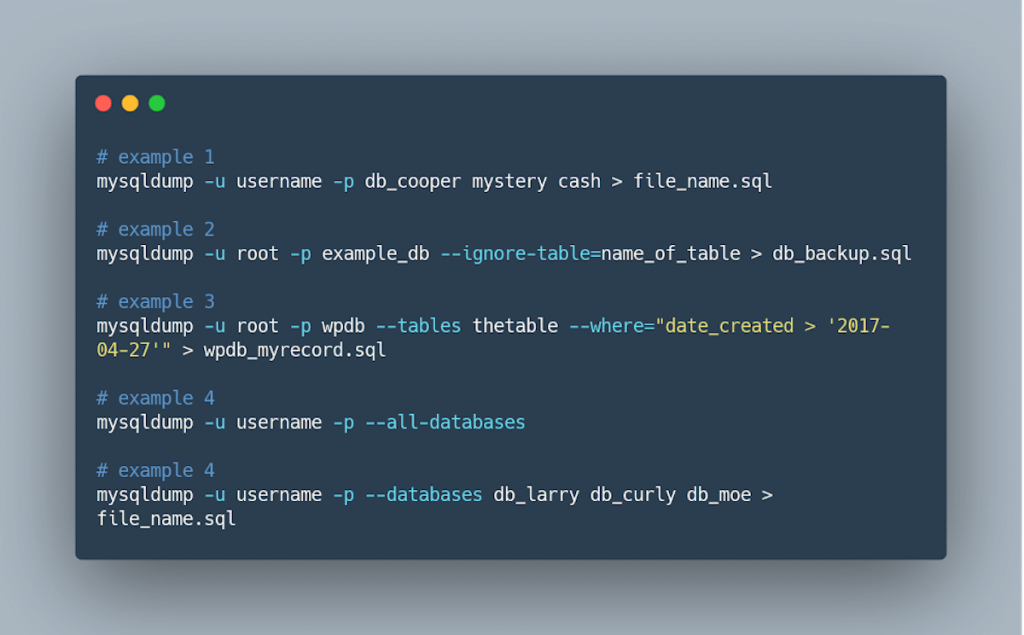Introduction to mysqldump
MySQL Database Engine provides its users with a handy client utility tool also known as mysqldump. You can leverage it to execute objective backups, generating a set of SQL statements that can be carried out to propagate the primal table data and database component descriptions. Mysqldump deposits one or more databases for migration or backup to a different server. To effectively use mysqldump, you also need the customer authorization along with the requisite privileges for the database you wish to migrate.
A few salient advantages of leveraging mysqldump for your operations include the flexibility and convenience of amending or even glancing at the output before the restoration process. Mysqldump also allows you to replicate databases for DBA operations and development. You can even use it to produce little variations of a current database to be used for testing. However, a crucial point to remeber here is that mysqldump is not meant to be a scalable or quick solution for backing up voluminous data.
Understanding Key Benefits of Backing Up Data
The primary value of keeping a replica for your data at various points in time is paramount. Any database installation not having a comprehensive data backup strategy spells disaster since a vast array of things could go wrong that might lead to permanent data loss or redundant data. To avoid this situation, organizations usually have a detailed procedure to execute periodic backups.
Another key benefit of maintaining periodic backups of your data is data versioning. Data Versioning refers to the specific versions of your data that are stored when any changes occur so that you can restore previous versions to extract the state of your ground truths then.
By maintaining periodic backups of your data, you also ensure a smooth transition during migration to a new development environment or server without having to worry about data loss.
Understanding the Types of MySQL Backup
Here are the different types of MySQL Backups that can be leveraged by its users:
- Hot: If your MySQL-based Database Server is functioning on top of an InnoDB Engine, you can produce consistent and transactional data backups without the need to halt to write to the MySQL Server.
- Physical: This backup can be created in MySQL can be created by duplicating the database files. It’s typically quicker to produce and restore a Physical Backup when compared to the Logical Backup. It is recommended that you leverage Physical Backup for larger databases.
- Logical: By leveraging Logical Backup, you end up with a .sql script to be used for database recreation. You can generate Logical Backup with the help of the mysqldump utility. The primary advantage of this backup is that it has no third-party dependencies and it can be restored on any MySQL Server seamlessly.
- Partial: In a Partial Backup, the backup is not created for the entire Database Management System (DBMS), but specific tables and databases. Partial Backup comes in handy when various backup strategies are executed on different data.
Creating a Backup of MySQL Database using mysqldump
When you install a MySQL Server, the primary backup utility mysqldump is automatically downloaded. It is recommended that you restore a large database using MySQL Export Database Command Line utility.
- Step 1: If you wish to create a backup of all the MySQL Server databases, you can run the following query:
mysqldump –user root –password –all-databases > all-databases.sql
- Step 2: primary purpose is to recover data, you can leverage the following query:
mysql –user root –password mysql < all-databases.sql
- Step 3: Generally, you would like to back up a single database as opposed to the entire MySQL Server. Therefore, to unload a particular database, you need to use the name of the database as opposed to the -all-database parameter as follows:
mysql –user root –password [db_name] < [db_name].sql
By creating the MySQL Backup in an open format, you can avail of two key advantages:
- You can manually amend the .sql file if you wish to modify something after the restoration process.
- You can also restore the deposit on a MySQL Server with a different version. Therefore, migrating to another version of MySQL can be executed without having to worry about backups.
Conclusion
This blog mentions the various salient aspects of leveraging mysqldump to backup your MySQL tables. It also gives a brief introduction to mysqldump before delving into the steps required to create a backup using mysqldump.

